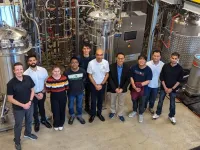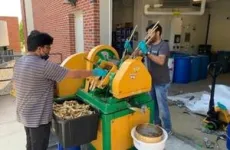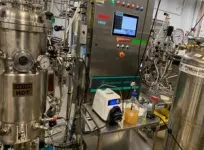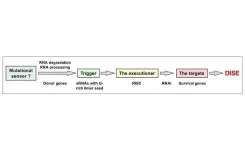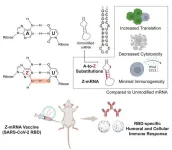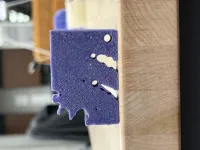(Press-News.org) In a breakthrough for environmentally friendly chemical production, researchers at the Center for Advanced Bioenergy and Bioproducts Innovation (CABBI) have developed an economical way to make succinic acid, an important industrial chemical, from sugarcane.
The team of University of Illinois and Princeton University researchers created a cost-effective, end-to-end pipeline for this valuable organic acid by engineering a tough, acid-tolerant yeast as the fermenting agent, avoiding costly steps in downstream processing. Succinic acid is a widely used additive for food and beverages and has diverse applications in agricultural and pharmaceutical products.
This same pipeline can be used to produce other industrially important organic acids targeted by CABBI in its work to develop sustainable biofuels and biochemicals from crops, said co-author Huimin Zhao, CABBI’s Conversion Theme Leader and Professor of Chemical and Biomolecular Engineering (ChBE) at Illinois. To reduce reliance on fossil fuels, Conversion researchers are deploying microbes to convert plant biomass into chemicals used in everyday products as an alternative to conventional petroleum-based production.
“This will serve as a blueprint for all the other metabolic engineering products in CABBI,” said Zhao, one of several CABBI principal investigators on the project. Other PIs included Vijay Singh, CABBI’s Deputy Director for Science & Technology, Distinguished and Founder Professor of Agricultural and Biological Engineering (ABE), and Executive Director of the Integrated Bioprocessing Research Laboratory (IBRL) at Illinois; Jeremy Guest, Associate Professor of Civil & Environmental Engineering (CEE) at Illinois and part of CABBI’s Sustainability Theme; and Conversion Deputy Theme Leader Joshua Rabinowitz, Professor of Chemistry and the Lewis-Sigler Institute for Integrative Genomics at Princeton.
The study, published in Nature Communications, is led by CABBI — a U.S. Department of Energy Bioenergy Research Center — and funded by BioMADE, a Manufacturing Innovation Institute with more than 230 member organizations around the country, including companies, universities, and nonprofit organizations. BioMADE was catalyzed by the U.S. Department of Defense and works to secure America’s future through bioindustrial manufacturing innovation, education, and collaboration.
The work builds on years of research on succinic acid production by Zhao and his colleagues using Issatchenkia orientalis, an unconventional yeast ideal for making organic acids.
I. orientalis has the unique ability to thrive in low-pH, or acidic, conditions. Most organisms require a neutral pH environment to survive, including Saccharomyces cerevisiae, a more conventional yeast, or Escherichia coli bacteria. Both have been used by companies and labs to produce succinic acid but proved to be too costly, so efforts to scale up production have failed, Zhao said.
Those microorganisms require the addition of a base to neutralize the toxic acidic conditions so they can continue making succinic acid. But that generates side products, such as gypsum or calcium sulfate, which have to be separated out at the end of the pipeline to purify the product, driving up downstream processing costs.
“One of the bottlenecks in the production of organic acids is the separation cost,” Zhao said. “We have to add a lot of base to keep the pH near neutral, between 6 to 7.”
With I. orientalis, however, “the organism lives happily at a pH of 3 to 4,” so the additives are not required, Zhao said. “In the end, that significantly reduces costs.”
The CABBI researchers also did extensive metabolic engineering to rewire I. orientalis to produce robust levels of succinic acid — higher than either S. cerevisiae or E. coli, he said. Using metabolic flux analysis from Rabinowitz’s lab, they identified the steps in the yeast’s metabolism that limited the production of succinic acid. One key roadblock: Native I. orientalis can’t utilize the sucrose from sugarcane. So an enzyme was added that could break down sucrose from the sugarcane juice into glucose and fructose to make succinic acid. Other genes were introduced to overproduce succinic acid.
Working with Singh’s group at IBRL, the team then scaled up succinic acid production using industrially relevant equipment to conduct an end-to-end integration of the process. The pilot-scale work showed the new strains could produce up to 110 g/L of succinic acid and, after batch fermentation and downstream processing, an overall yield of 64% — impressive results having commercial significance, Singh said.
The combination of higher production levels through genetic engineering and lower costs from the elimination of downstream separation makes the process “very attractive,” Zhao said. “That’s why the pipeline is so economical, at least at this pilot scale.”
The final step was working with Guest to simulate a full end-to-end, low-pH succinic acid production pipeline, using the open-source software platform BioSTEAM developed by his group. The techno-economic analysis (TEA) and life cycle assessment showed the process was financially viable and could reduce greenhouse gas emissions by 34% to 90% relative to fossil fuel-based production processes.
“These advancements in metabolic engineering could have large-scale benefits, simultaneously driving down costs and environmental impacts in support of a circular bioeconomy,” Guest said.
The process emits less carbon dioxide (CO2) than conventional petroleum-based chemical processing. Plants like sugarcane also soak up carbon, and CO2 can be used as a substrate for the process, further reducing its carbon footprint.
“It’s definitely more environmentally friendly. That’s the premise for all the research in CABBI: using renewable resources to make chemicals and fuels,” Zhao said.
Researchers plan further scale-up studies soon to support commercialization of the succinic acid production process.
The work will also be a template for production of other CABBI products using I. orientalis, including 3-hydroxypropionic acid (3-HP). The market for 3-HP, used in components of disposable diapers and sealants, exceeds $1 billion, and research to date shows huge promise, Zhao said.
“We expect I. orientalis can serve as a general industrial platform for the production of a wide variety of organic acids,” said Vinh Tran, primary author on the paper and a Ph.D. student in ChBE.
The project involved several lab groups and contributions from all three themes of CABBI’s research — using sugarcane juice from the Feedstock Production research team, metabolic research and bioprocessing facilities from the Conversion team, and economic and environmental analysis from the Sustainability team.
Co-authors included CABBI researchers Sarang Bhagwat of CEE and Yihui Shen of the Department of Chemistry at Princeton; Somesh Mishra of ABE; Saman Shafaei, Shih-I Tan, Zia Fatma, and Benjamin Crosly of ChBE; and Jayne Allen of CEE.
END
New pipeline makes valuable organic acid from plants — saving money and emissions
CABBI team engineers acid-tolerant yeast to economically produce succinic acid, key chemical in food, agricultural and pharmaceutical products
2023-10-03
ELSE PRESS RELEASES FROM THIS DATE:
PARMESAN: An AI-based predictive tool to find new treatments for genetic disorders
2023-10-03
To discover new treatments for genetic disorders, scientists need a thorough knowledge of prior literature to determine the best gene/protein targets and the most promising drugs to test. However, biomedical literature is growing at an explosive rate and often contains conflicting information, making it increasingly time-consuming for researchers to conduct a complete and thorough review.
To address this challenge, Cole Deisseroth, a graduate student enrolled in the M.D./Ph.D. program and mentored by Drs. Huda Zoghbi and Zhandong Liu at the Jan and Duncan ...
PPPL awarded $5 million to lead an Energy Earthshot Research Center focused on clean hydrogen
2023-10-03
Lessening the effects of climate change will require a variety of innovations and a lot of ingenuity. Now, a new center led by the U.S. Department of Energy’s (DOE) Princeton Plasma Physics Laboratory (PPPL) will help these efforts by advancing the understanding of plasma-based clean hydrogen production.
PPPL was selected to lead a DOE Energy Earthshot Research Center (EERC) as part of the Hydrogen Shot™, which aims to reduce the cost of hydrogen by 80%. With funding from the DOE’s Office of Science, the EERCs support fundamental ...
Illinois-led project to sequence 400 soybean genomes, improve future crops
2023-10-03
As a source of protein and biodiesel for cleaner renewable energy, soybean is an important crop worldwide. But is it performing to its full potential? An ambitious effort led by the University of Illinois Urbana-Champaign and the U.S. Department of Energy Joint Genome Institute (JGI) will sequence 400 soybean genomes to develop a “pangenome” — an attempt to characterize all the useful diversity in the genome to create an even more robust and resilient crop.
The soybean pangenome project will sequence and analyze at least 50 soybean genomes from cultivated lines and wild relatives at reference quality, the gold standard of modern sequencing. A further ...
An ancient anti-cancer mechanism: DISE
2023-10-03
“DISE is effective against all cancers we tested.”
A new editorial paper was published in Oncotarget's Volume 14 on September 25, 2023, entitled, “DISE, an ancient anti-cancer mechanism that senses mutational load in cancerous cells?”
In their new editorial, researchers Monal Patel and Marcus E. Peter from Northwestern University discuss a recent breakthrough in cancer therapy. Despite the multiple advances in therapy, cancer remains one of the most common causes of death globally. ...
Project aims to develop all-in-one semiconductor that stores, processes data
2023-10-03
A multi-institutional project led by a Penn State researcher is focused on developing an all-in-one semiconductor device that can both store data and perform computations. The project recently received $2 million in funding over three years as part of the new National Science Foundation Future of Semiconductors (FuSe) program, a $45.6 million investment to advance semiconductor technologies and manufacturing through 24 research and education projects across the United States.
“The goal of ...
Nemours Children’s Health hosts first-ever pediatric session at HLTH
2023-10-03
Nemours Children’s Health will host the first-ever dedicated pediatric session at HLTH, the leading platform bringing together the entire health ecosystem focused on health innovation and transformation. This invited program, “Elevating Kids Health Well Beyond Medicine,” will extend HLTH’s 2023 theme, “Elevating Humanity,” to focus on health in childhood and why it is the only way to build good health across the lifespan.
“The child health perspective is an essential viewpoint for the attendees of HLTH to consider and we are proud to offer ...
OU Engineering among top 28 teams nationwide selected for DEPSCoR Grant
2023-10-03
University of Oklahoma engineering researcher Reza Foudazi, Ph.D., has been selected to receive a $600,000 grant from the U.S. Department of Defense under the Defense Established Program to Stimulate Competitive Research, or DEPSCoR. The highly competitive grant was awarded to only 28 academic teams nationwide.
An associate professor in the School of Sustainable Chemical, Biological and Materials Engineering, Foudazi’s research centers on the exploration of electrochemical energy storage systems that incorporate multivalent ions. ...
From A to Z: An alternative base modification for mRNA therapeutics
2023-10-03
Messenger RNA (mRNA) technology has become popular in the last few years due to its use in COVID-19 vaccines. This technology has been so groundbreaking that it recently won the 2023 Nobel Prize in medicine “for discoveries concerning nucleoside base modifications that enabled the development of effective mRNA vaccines against COVID-19.” This isn’t new technology, however— modified mRNAs have been studied for decades and show significant potential for therapeutic applications. Compared to unmodified mRNAs, modified ...
Legendary UTA professor establishes endowed professorship in heat transfer
2023-10-03
Abdolhossein Haji-Sheikh, a retired professor in the Mechanical and Aerospace Engineering Department at The University of Texas at Arlington, has made a $500,000 gift to support his former department.
The gift creates an endowed professorship in heat transfer, one of Haji-Sheikh’s areas of expertise during his decades of teaching at UTA. The professorship will be awarded in 2026.
Haji-Sheikh began his career at what was then Arlington State College in 1966. He said he wants to give back to ...
Instant evolution: AI designs new robot from scratch in seconds
2023-10-03
Inventor of xenobots unveils new advance toward artificial life
New AI algorithm compresses billions of years of evolution into seconds
The evolved robot has three legs and rear fins, something a human engineer would never devise
Researcher: ‘Now anyone can watch evolution in action as AI generates better and better robot bodies in real time.’
A team led by Northwestern University researchers has developed the first artificial intelligence (AI) to date that can intelligently design robots from ...
LAST 30 PRESS RELEASES:
Numbers in our sights affect how we perceive space
SIMJ announces global collaborative book project in commemoration of its 75th anniversary
Air pollution exposure and birth weight
Obstructive sleep apnea risk and mental health conditions among older adults
How talking slows eye movements behind the wheel
The Ceramic Society of Japan’s Oxoate Ceramics Research Association launches new international book project
Heart-brain connection: international study reveals the role of the vagus nerve in keeping the heart young
Researchers identify Rb1 as a predictive biomarker for a new therapeutic strategy in some breast cancers
Survey reveals ethical gaps slowing AI adoption in pediatric surgery
Stimulant ADHD medications work differently than thought
AI overestimates how smart people are, according to HSE economists
HSE researchers create genome-wide map of quadruplexes
Scientists boost cell "powerhouses" to burn more calories
Automatic label checking: The missing step in making reliable medical AI
Low daily alcohol intake linked to 50% heightened mouth cancer risk in India
American Meteorological Society announces Rick Spinrad as 2026 President-Elect
Biomass-based carbon capture spotlighted in newly released global climate webinar recording
Illuminating invisible nano pollutants: advanced bioimaging tracks the full journey of emerging nanoscale contaminants in living systems
How does age affect recovery from spinal cord injury?
Novel AI tool offers prognosis for patients with head and neck cancer
Fathers’ microplastic exposure tied to their children’s metabolic problems
Research validates laboratory model for studying high-grade serous ovarian cancer
SIR 2026 delivers transformative breakthroughs in minimally invasive medicine to improve patient care
Stem Cell Reports most downloaded papers of 2025 highlight the breadth and impact of stem cell research
Oxford-led study estimates NHS spends around 3% of its primary and secondary care budget on the health impacts of heat and cold in England
A researcher’s long quest leads to a smart composite breakthrough
Urban wild bees act as “microbial sensors” of city health.
New study finds where you live affects recovery after a hip fracture
Forecasting the impact of fully automated vehicle adoption on US road traffic injuries
Alcohol-related hospitalizations from 2016 to 2022
[Press-News.org] New pipeline makes valuable organic acid from plants — saving money and emissionsCABBI team engineers acid-tolerant yeast to economically produce succinic acid, key chemical in food, agricultural and pharmaceutical products
